Leadership and Management in Nursing: Strategies, ACA & Delegation
VerifiedAdded on 2023/04/24
|19
|4110
|238
Report
AI Summary
This report provides a comprehensive overview of nursing leadership and management, focusing on key strategies, the Affordable Care Act (ACA), and delegation. It begins by comparing and contrasting leadership and management, highlighting transformational leadership as a beneficial style for nurses. Strategies for empowering leaders and managers are discussed, emphasizing vision creation and relationship building. The report then examines organizational climate and motivation within a critical care unit, suggesting actions for improvement such as employee motivation and conflict resolution. An analysis of the Affordable Care Act follows, detailing its influence on healthcare organizations, including staffing and decision-making, with both positive and negative impacts considered. Finally, the report addresses delegation in nursing, summarizing delegation guidelines, analyzing the risks of inappropriate delegation, identifying barriers to delegation, and describing strategies to reduce legal risks and improve team efficiency. The document is available on Desklib, a platform offering study tools and solved assignments for students.
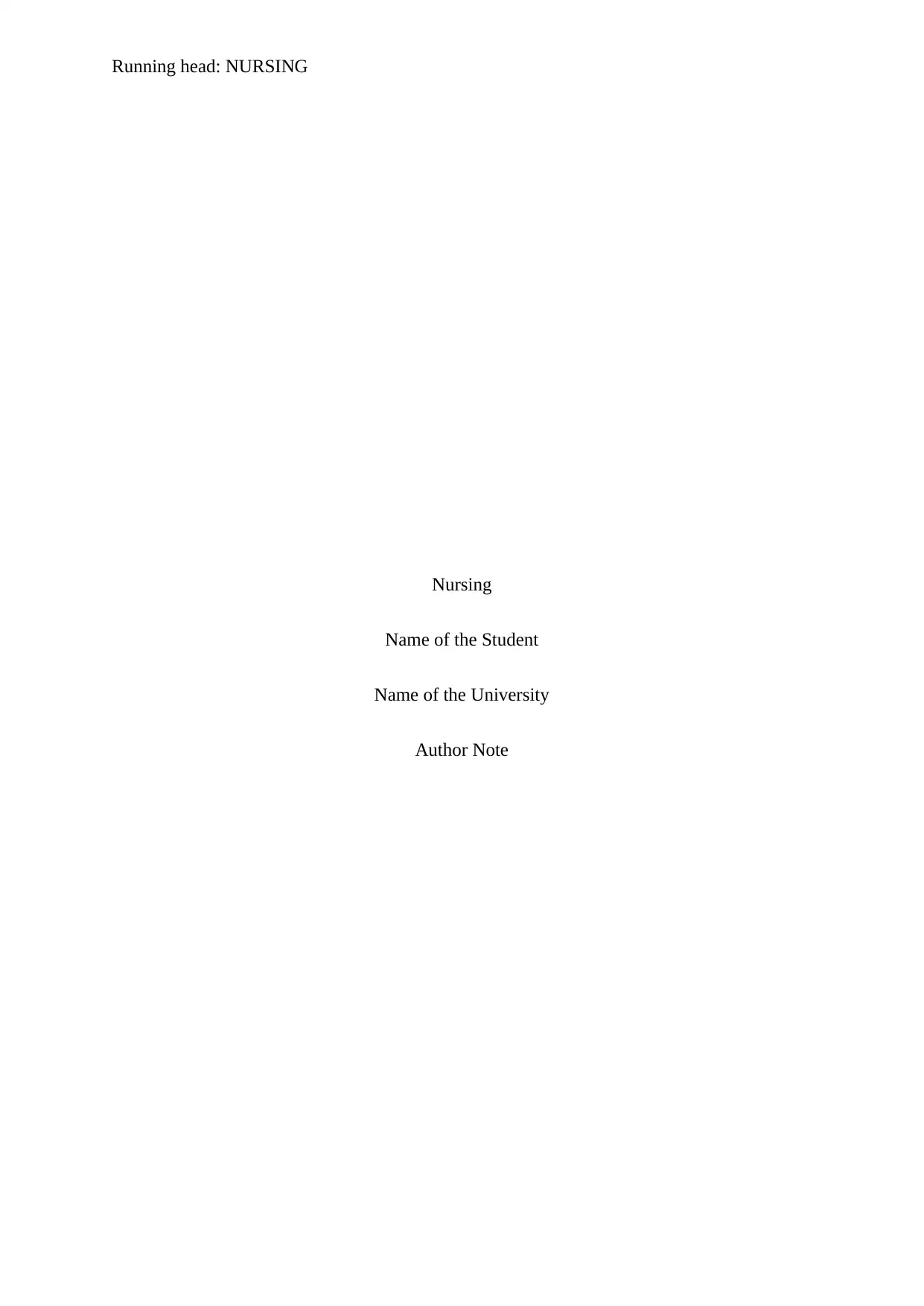
Running head: NURSING
Nursing
Name of the Student
Name of the University
Author Note
Nursing
Name of the Student
Name of the University
Author Note
Paraphrase This Document
Need a fresh take? Get an instant paraphrase of this document with our AI Paraphraser
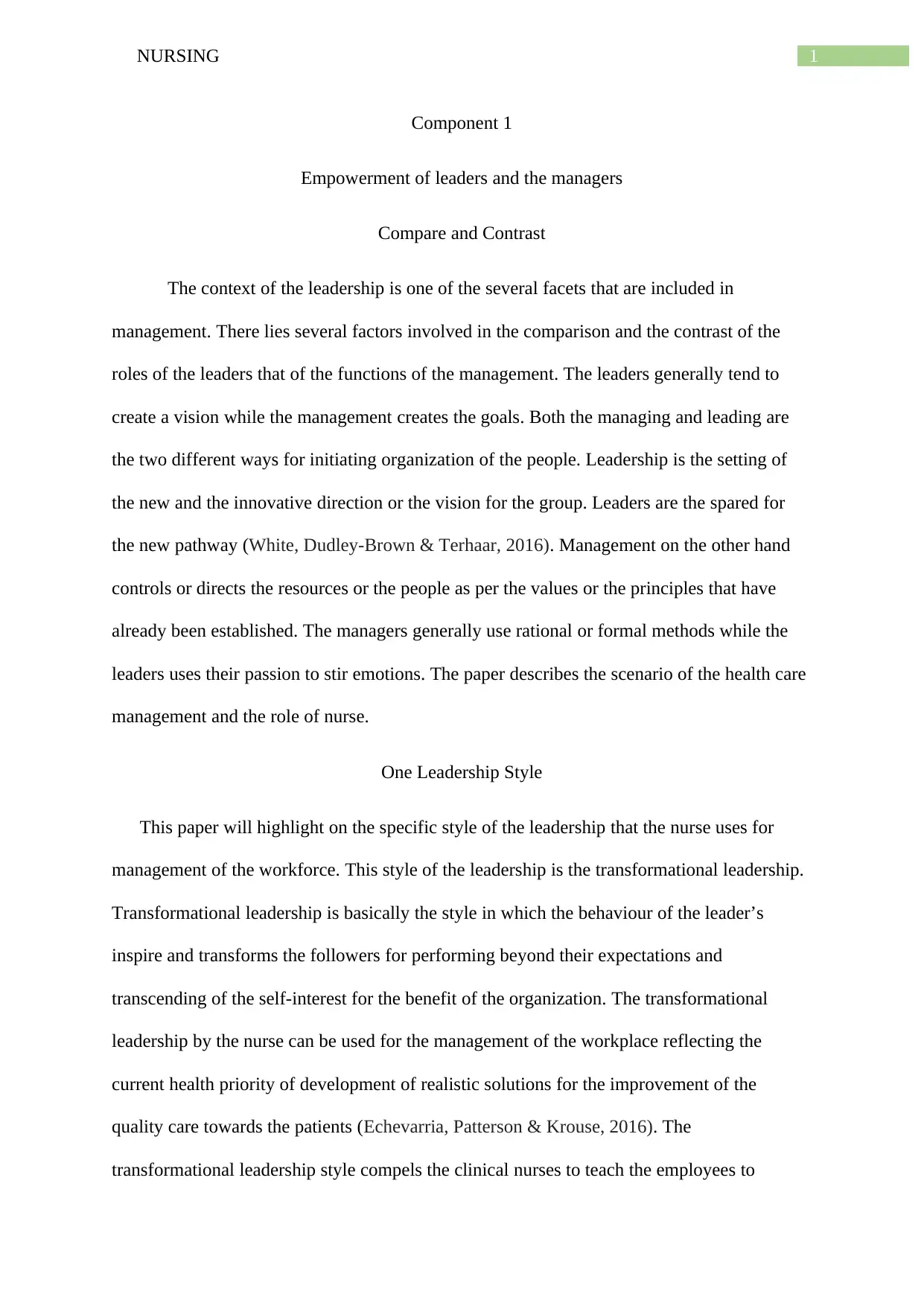
1NURSING
Component 1
Empowerment of leaders and the managers
Compare and Contrast
The context of the leadership is one of the several facets that are included in
management. There lies several factors involved in the comparison and the contrast of the
roles of the leaders that of the functions of the management. The leaders generally tend to
create a vision while the management creates the goals. Both the managing and leading are
the two different ways for initiating organization of the people. Leadership is the setting of
the new and the innovative direction or the vision for the group. Leaders are the spared for
the new pathway (White, Dudley-Brown & Terhaar, 2016). Management on the other hand
controls or directs the resources or the people as per the values or the principles that have
already been established. The managers generally use rational or formal methods while the
leaders uses their passion to stir emotions. The paper describes the scenario of the health care
management and the role of nurse.
One Leadership Style
This paper will highlight on the specific style of the leadership that the nurse uses for
management of the workforce. This style of the leadership is the transformational leadership.
Transformational leadership is basically the style in which the behaviour of the leader’s
inspire and transforms the followers for performing beyond their expectations and
transcending of the self-interest for the benefit of the organization. The transformational
leadership by the nurse can be used for the management of the workplace reflecting the
current health priority of development of realistic solutions for the improvement of the
quality care towards the patients (Echevarria, Patterson & Krouse, 2016). The
transformational leadership style compels the clinical nurses to teach the employees to
Component 1
Empowerment of leaders and the managers
Compare and Contrast
The context of the leadership is one of the several facets that are included in
management. There lies several factors involved in the comparison and the contrast of the
roles of the leaders that of the functions of the management. The leaders generally tend to
create a vision while the management creates the goals. Both the managing and leading are
the two different ways for initiating organization of the people. Leadership is the setting of
the new and the innovative direction or the vision for the group. Leaders are the spared for
the new pathway (White, Dudley-Brown & Terhaar, 2016). Management on the other hand
controls or directs the resources or the people as per the values or the principles that have
already been established. The managers generally use rational or formal methods while the
leaders uses their passion to stir emotions. The paper describes the scenario of the health care
management and the role of nurse.
One Leadership Style
This paper will highlight on the specific style of the leadership that the nurse uses for
management of the workforce. This style of the leadership is the transformational leadership.
Transformational leadership is basically the style in which the behaviour of the leader’s
inspire and transforms the followers for performing beyond their expectations and
transcending of the self-interest for the benefit of the organization. The transformational
leadership by the nurse can be used for the management of the workplace reflecting the
current health priority of development of realistic solutions for the improvement of the
quality care towards the patients (Echevarria, Patterson & Krouse, 2016). The
transformational leadership style compels the clinical nurses to teach the employees to
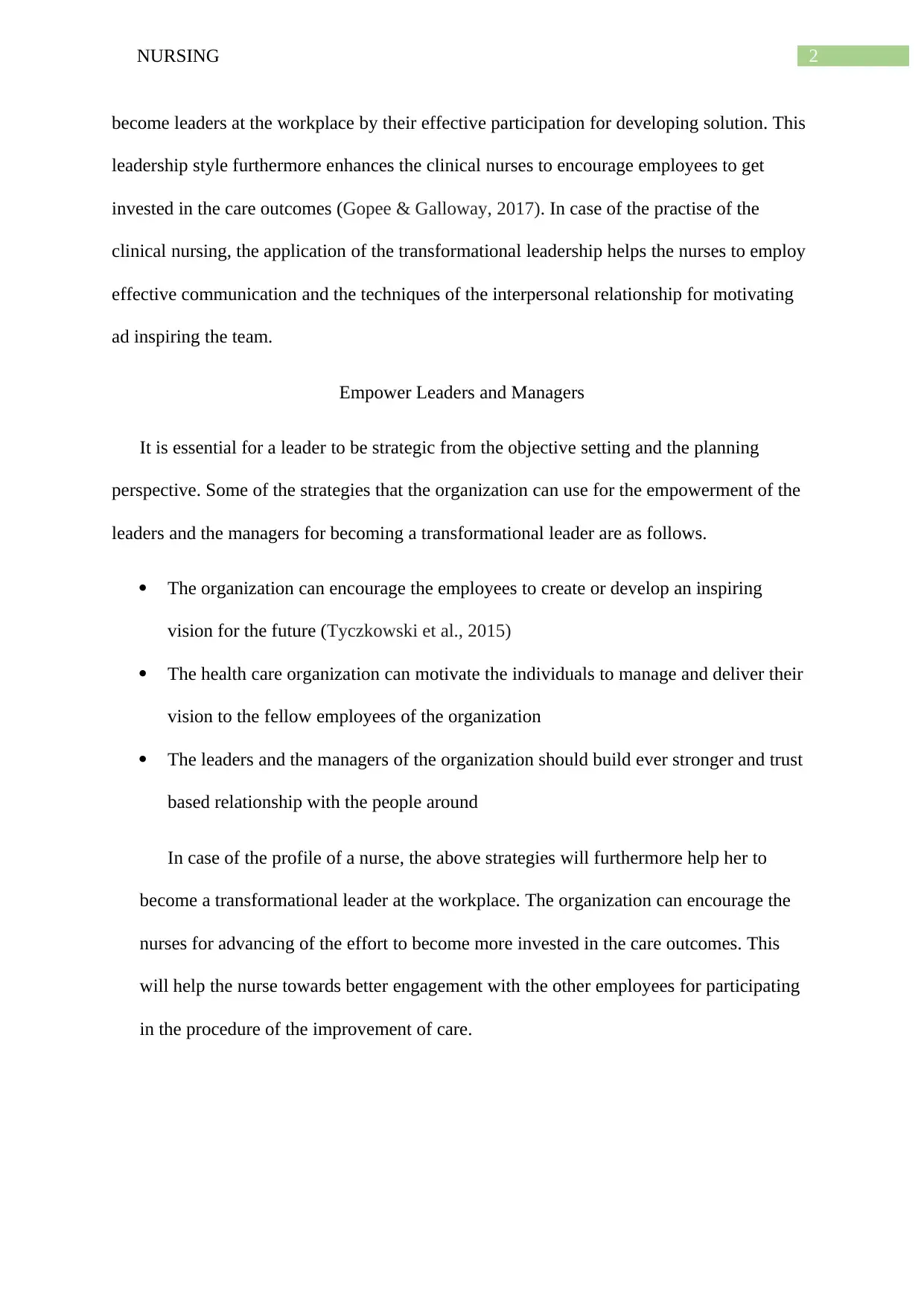
2NURSING
become leaders at the workplace by their effective participation for developing solution. This
leadership style furthermore enhances the clinical nurses to encourage employees to get
invested in the care outcomes (Gopee & Galloway, 2017). In case of the practise of the
clinical nursing, the application of the transformational leadership helps the nurses to employ
effective communication and the techniques of the interpersonal relationship for motivating
ad inspiring the team.
Empower Leaders and Managers
It is essential for a leader to be strategic from the objective setting and the planning
perspective. Some of the strategies that the organization can use for the empowerment of the
leaders and the managers for becoming a transformational leader are as follows.
The organization can encourage the employees to create or develop an inspiring
vision for the future (Tyczkowski et al., 2015)
The health care organization can motivate the individuals to manage and deliver their
vision to the fellow employees of the organization
The leaders and the managers of the organization should build ever stronger and trust
based relationship with the people around
In case of the profile of a nurse, the above strategies will furthermore help her to
become a transformational leader at the workplace. The organization can encourage the
nurses for advancing of the effort to become more invested in the care outcomes. This
will help the nurse towards better engagement with the other employees for participating
in the procedure of the improvement of care.
become leaders at the workplace by their effective participation for developing solution. This
leadership style furthermore enhances the clinical nurses to encourage employees to get
invested in the care outcomes (Gopee & Galloway, 2017). In case of the practise of the
clinical nursing, the application of the transformational leadership helps the nurses to employ
effective communication and the techniques of the interpersonal relationship for motivating
ad inspiring the team.
Empower Leaders and Managers
It is essential for a leader to be strategic from the objective setting and the planning
perspective. Some of the strategies that the organization can use for the empowerment of the
leaders and the managers for becoming a transformational leader are as follows.
The organization can encourage the employees to create or develop an inspiring
vision for the future (Tyczkowski et al., 2015)
The health care organization can motivate the individuals to manage and deliver their
vision to the fellow employees of the organization
The leaders and the managers of the organization should build ever stronger and trust
based relationship with the people around
In case of the profile of a nurse, the above strategies will furthermore help her to
become a transformational leader at the workplace. The organization can encourage the
nurses for advancing of the effort to become more invested in the care outcomes. This
will help the nurse towards better engagement with the other employees for participating
in the procedure of the improvement of care.
⊘ This is a preview!⊘
Do you want full access?
Subscribe today to unlock all pages.

Trusted by 1+ million students worldwide
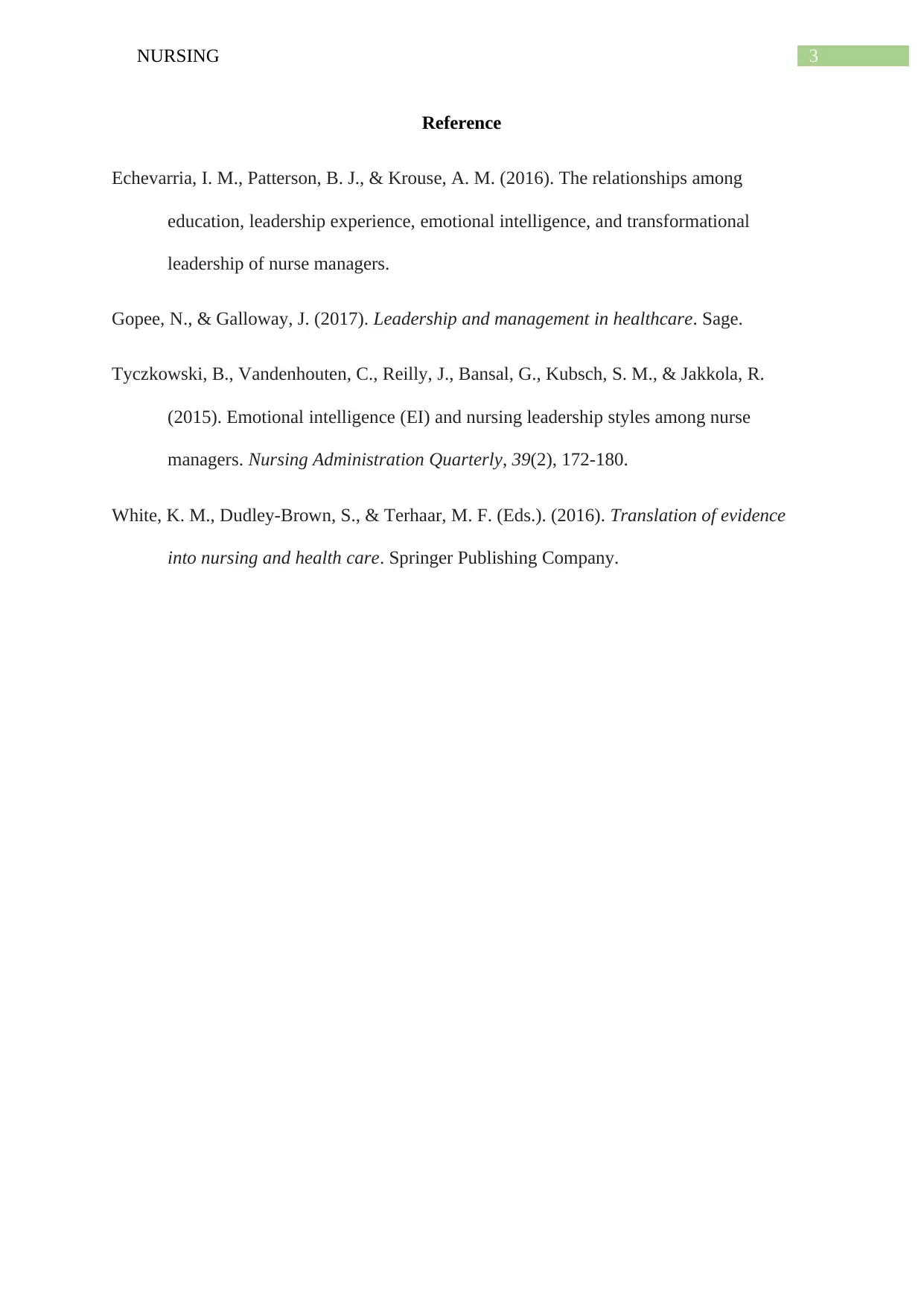
3NURSING
Reference
Echevarria, I. M., Patterson, B. J., & Krouse, A. M. (2016). The relationships among
education, leadership experience, emotional intelligence, and transformational
leadership of nurse managers.
Gopee, N., & Galloway, J. (2017). Leadership and management in healthcare. Sage.
Tyczkowski, B., Vandenhouten, C., Reilly, J., Bansal, G., Kubsch, S. M., & Jakkola, R.
(2015). Emotional intelligence (EI) and nursing leadership styles among nurse
managers. Nursing Administration Quarterly, 39(2), 172-180.
White, K. M., Dudley-Brown, S., & Terhaar, M. F. (Eds.). (2016). Translation of evidence
into nursing and health care. Springer Publishing Company.
Reference
Echevarria, I. M., Patterson, B. J., & Krouse, A. M. (2016). The relationships among
education, leadership experience, emotional intelligence, and transformational
leadership of nurse managers.
Gopee, N., & Galloway, J. (2017). Leadership and management in healthcare. Sage.
Tyczkowski, B., Vandenhouten, C., Reilly, J., Bansal, G., Kubsch, S. M., & Jakkola, R.
(2015). Emotional intelligence (EI) and nursing leadership styles among nurse
managers. Nursing Administration Quarterly, 39(2), 172-180.
White, K. M., Dudley-Brown, S., & Terhaar, M. F. (Eds.). (2016). Translation of evidence
into nursing and health care. Springer Publishing Company.
Paraphrase This Document
Need a fresh take? Get an instant paraphrase of this document with our AI Paraphraser
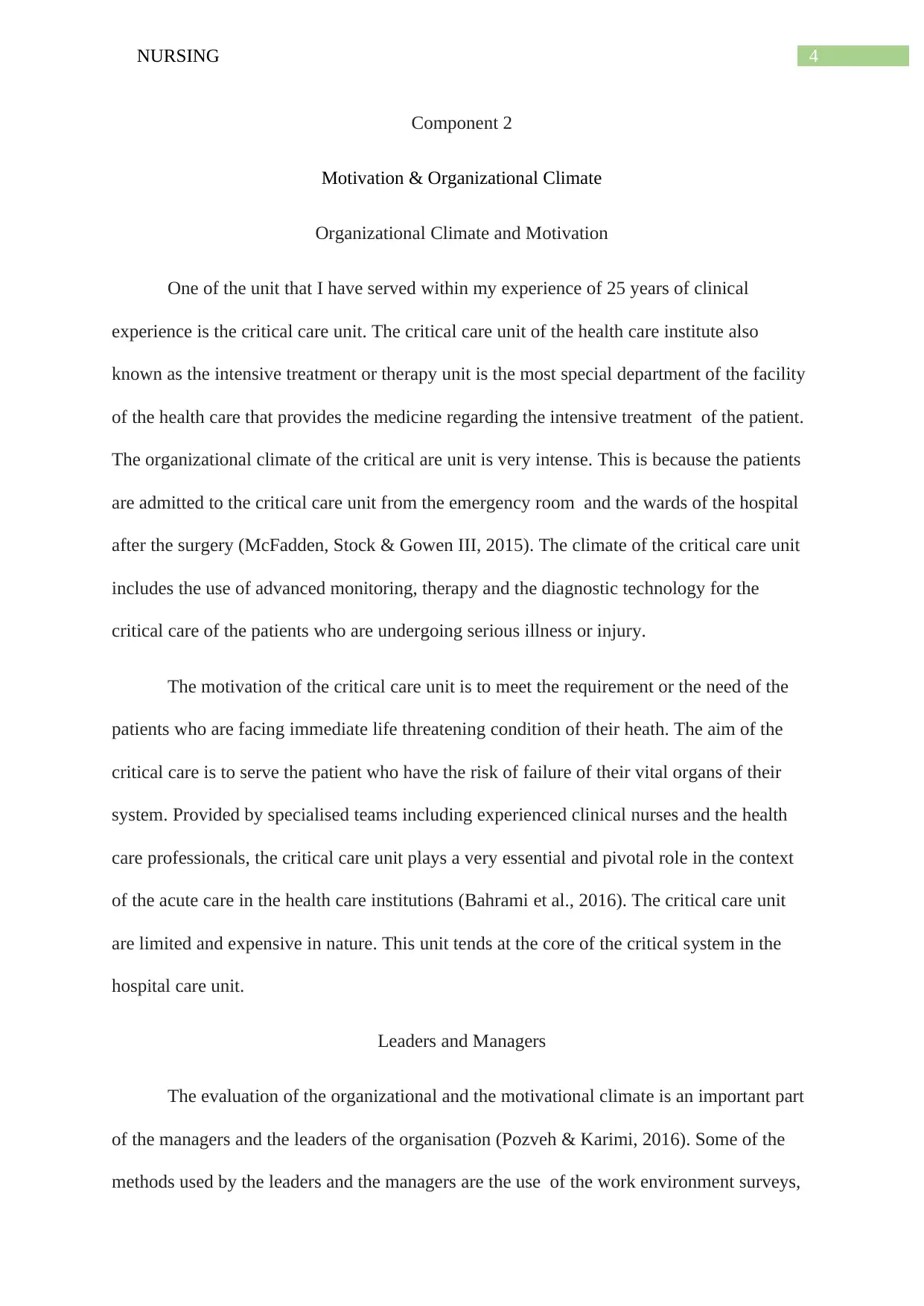
4NURSING
Component 2
Motivation & Organizational Climate
Organizational Climate and Motivation
One of the unit that I have served within my experience of 25 years of clinical
experience is the critical care unit. The critical care unit of the health care institute also
known as the intensive treatment or therapy unit is the most special department of the facility
of the health care that provides the medicine regarding the intensive treatment of the patient.
The organizational climate of the critical are unit is very intense. This is because the patients
are admitted to the critical care unit from the emergency room and the wards of the hospital
after the surgery (McFadden, Stock & Gowen III, 2015). The climate of the critical care unit
includes the use of advanced monitoring, therapy and the diagnostic technology for the
critical care of the patients who are undergoing serious illness or injury.
The motivation of the critical care unit is to meet the requirement or the need of the
patients who are facing immediate life threatening condition of their heath. The aim of the
critical care is to serve the patient who have the risk of failure of their vital organs of their
system. Provided by specialised teams including experienced clinical nurses and the health
care professionals, the critical care unit plays a very essential and pivotal role in the context
of the acute care in the health care institutions (Bahrami et al., 2016). The critical care unit
are limited and expensive in nature. This unit tends at the core of the critical system in the
hospital care unit.
Leaders and Managers
The evaluation of the organizational and the motivational climate is an important part
of the managers and the leaders of the organisation (Pozveh & Karimi, 2016). Some of the
methods used by the leaders and the managers are the use of the work environment surveys,
Component 2
Motivation & Organizational Climate
Organizational Climate and Motivation
One of the unit that I have served within my experience of 25 years of clinical
experience is the critical care unit. The critical care unit of the health care institute also
known as the intensive treatment or therapy unit is the most special department of the facility
of the health care that provides the medicine regarding the intensive treatment of the patient.
The organizational climate of the critical are unit is very intense. This is because the patients
are admitted to the critical care unit from the emergency room and the wards of the hospital
after the surgery (McFadden, Stock & Gowen III, 2015). The climate of the critical care unit
includes the use of advanced monitoring, therapy and the diagnostic technology for the
critical care of the patients who are undergoing serious illness or injury.
The motivation of the critical care unit is to meet the requirement or the need of the
patients who are facing immediate life threatening condition of their heath. The aim of the
critical care is to serve the patient who have the risk of failure of their vital organs of their
system. Provided by specialised teams including experienced clinical nurses and the health
care professionals, the critical care unit plays a very essential and pivotal role in the context
of the acute care in the health care institutions (Bahrami et al., 2016). The critical care unit
are limited and expensive in nature. This unit tends at the core of the critical system in the
hospital care unit.
Leaders and Managers
The evaluation of the organizational and the motivational climate is an important part
of the managers and the leaders of the organisation (Pozveh & Karimi, 2016). Some of the
methods used by the leaders and the managers are the use of the work environment surveys,
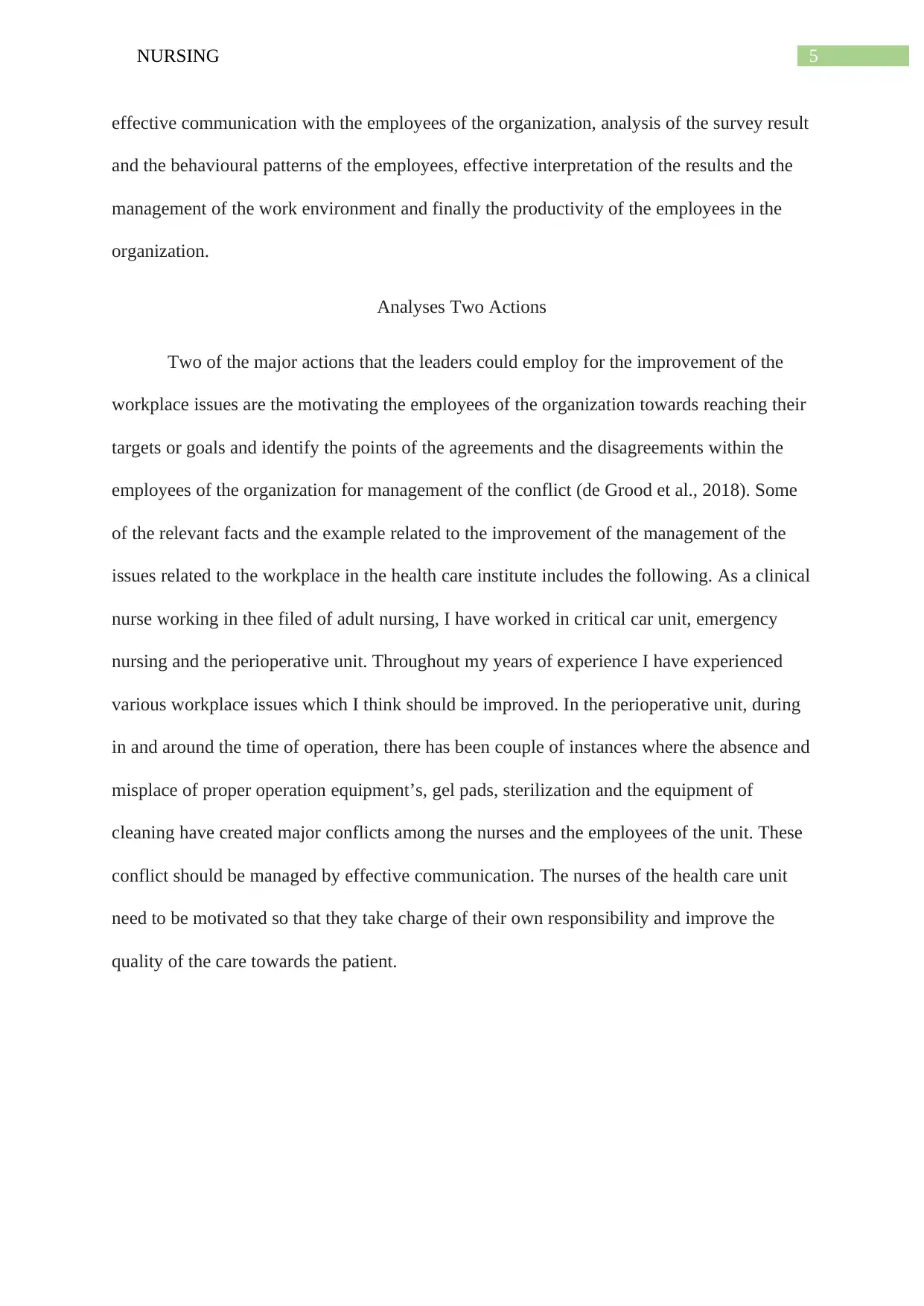
5NURSING
effective communication with the employees of the organization, analysis of the survey result
and the behavioural patterns of the employees, effective interpretation of the results and the
management of the work environment and finally the productivity of the employees in the
organization.
Analyses Two Actions
Two of the major actions that the leaders could employ for the improvement of the
workplace issues are the motivating the employees of the organization towards reaching their
targets or goals and identify the points of the agreements and the disagreements within the
employees of the organization for management of the conflict (de Grood et al., 2018). Some
of the relevant facts and the example related to the improvement of the management of the
issues related to the workplace in the health care institute includes the following. As a clinical
nurse working in thee filed of adult nursing, I have worked in critical car unit, emergency
nursing and the perioperative unit. Throughout my years of experience I have experienced
various workplace issues which I think should be improved. In the perioperative unit, during
in and around the time of operation, there has been couple of instances where the absence and
misplace of proper operation equipment’s, gel pads, sterilization and the equipment of
cleaning have created major conflicts among the nurses and the employees of the unit. These
conflict should be managed by effective communication. The nurses of the health care unit
need to be motivated so that they take charge of their own responsibility and improve the
quality of the care towards the patient.
effective communication with the employees of the organization, analysis of the survey result
and the behavioural patterns of the employees, effective interpretation of the results and the
management of the work environment and finally the productivity of the employees in the
organization.
Analyses Two Actions
Two of the major actions that the leaders could employ for the improvement of the
workplace issues are the motivating the employees of the organization towards reaching their
targets or goals and identify the points of the agreements and the disagreements within the
employees of the organization for management of the conflict (de Grood et al., 2018). Some
of the relevant facts and the example related to the improvement of the management of the
issues related to the workplace in the health care institute includes the following. As a clinical
nurse working in thee filed of adult nursing, I have worked in critical car unit, emergency
nursing and the perioperative unit. Throughout my years of experience I have experienced
various workplace issues which I think should be improved. In the perioperative unit, during
in and around the time of operation, there has been couple of instances where the absence and
misplace of proper operation equipment’s, gel pads, sterilization and the equipment of
cleaning have created major conflicts among the nurses and the employees of the unit. These
conflict should be managed by effective communication. The nurses of the health care unit
need to be motivated so that they take charge of their own responsibility and improve the
quality of the care towards the patient.
⊘ This is a preview!⊘
Do you want full access?
Subscribe today to unlock all pages.

Trusted by 1+ million students worldwide
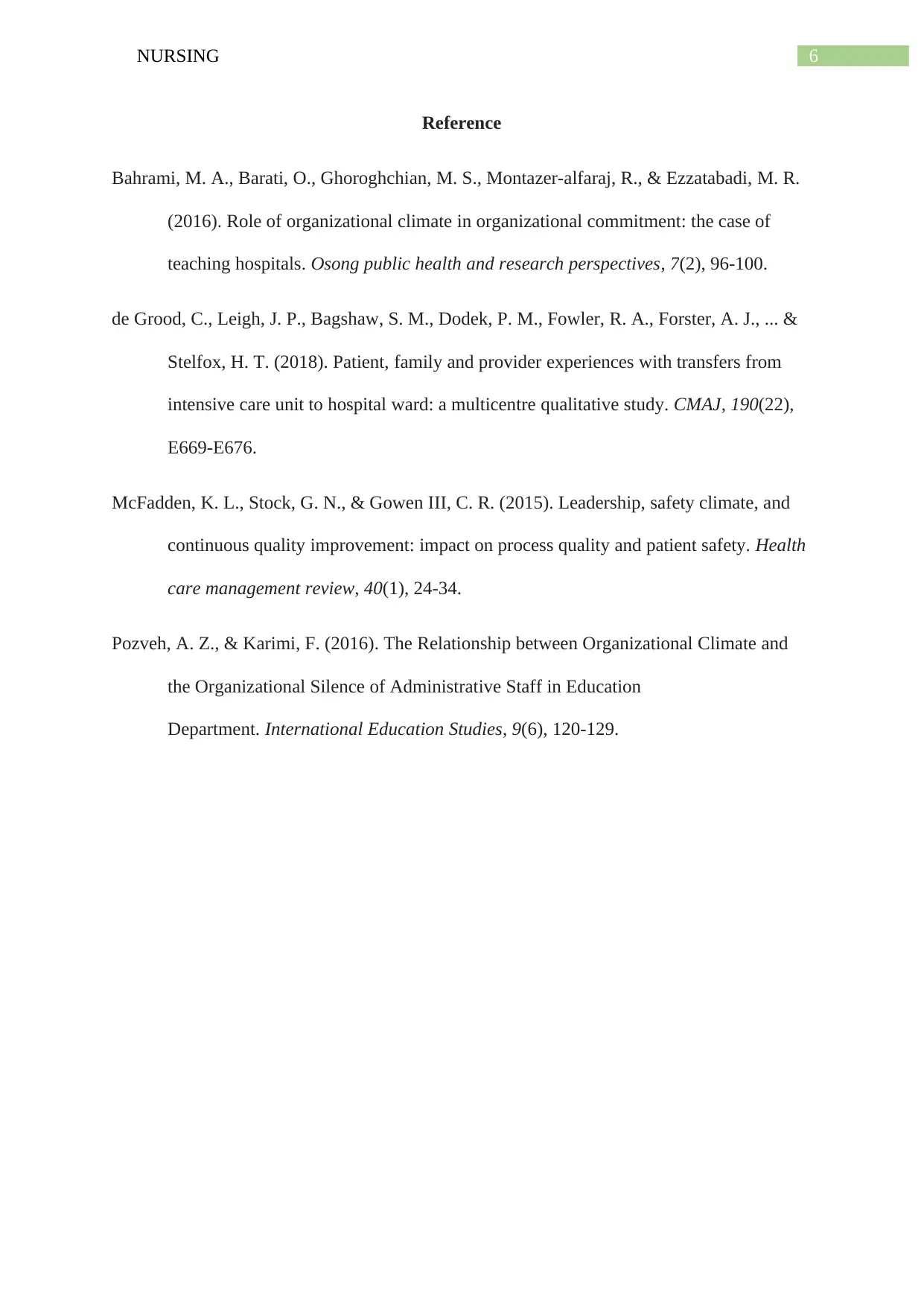
6NURSING
Reference
Bahrami, M. A., Barati, O., Ghoroghchian, M. S., Montazer-alfaraj, R., & Ezzatabadi, M. R.
(2016). Role of organizational climate in organizational commitment: the case of
teaching hospitals. Osong public health and research perspectives, 7(2), 96-100.
de Grood, C., Leigh, J. P., Bagshaw, S. M., Dodek, P. M., Fowler, R. A., Forster, A. J., ... &
Stelfox, H. T. (2018). Patient, family and provider experiences with transfers from
intensive care unit to hospital ward: a multicentre qualitative study. CMAJ, 190(22),
E669-E676.
McFadden, K. L., Stock, G. N., & Gowen III, C. R. (2015). Leadership, safety climate, and
continuous quality improvement: impact on process quality and patient safety. Health
care management review, 40(1), 24-34.
Pozveh, A. Z., & Karimi, F. (2016). The Relationship between Organizational Climate and
the Organizational Silence of Administrative Staff in Education
Department. International Education Studies, 9(6), 120-129.
Reference
Bahrami, M. A., Barati, O., Ghoroghchian, M. S., Montazer-alfaraj, R., & Ezzatabadi, M. R.
(2016). Role of organizational climate in organizational commitment: the case of
teaching hospitals. Osong public health and research perspectives, 7(2), 96-100.
de Grood, C., Leigh, J. P., Bagshaw, S. M., Dodek, P. M., Fowler, R. A., Forster, A. J., ... &
Stelfox, H. T. (2018). Patient, family and provider experiences with transfers from
intensive care unit to hospital ward: a multicentre qualitative study. CMAJ, 190(22),
E669-E676.
McFadden, K. L., Stock, G. N., & Gowen III, C. R. (2015). Leadership, safety climate, and
continuous quality improvement: impact on process quality and patient safety. Health
care management review, 40(1), 24-34.
Pozveh, A. Z., & Karimi, F. (2016). The Relationship between Organizational Climate and
the Organizational Silence of Administrative Staff in Education
Department. International Education Studies, 9(6), 120-129.
Paraphrase This Document
Need a fresh take? Get an instant paraphrase of this document with our AI Paraphraser
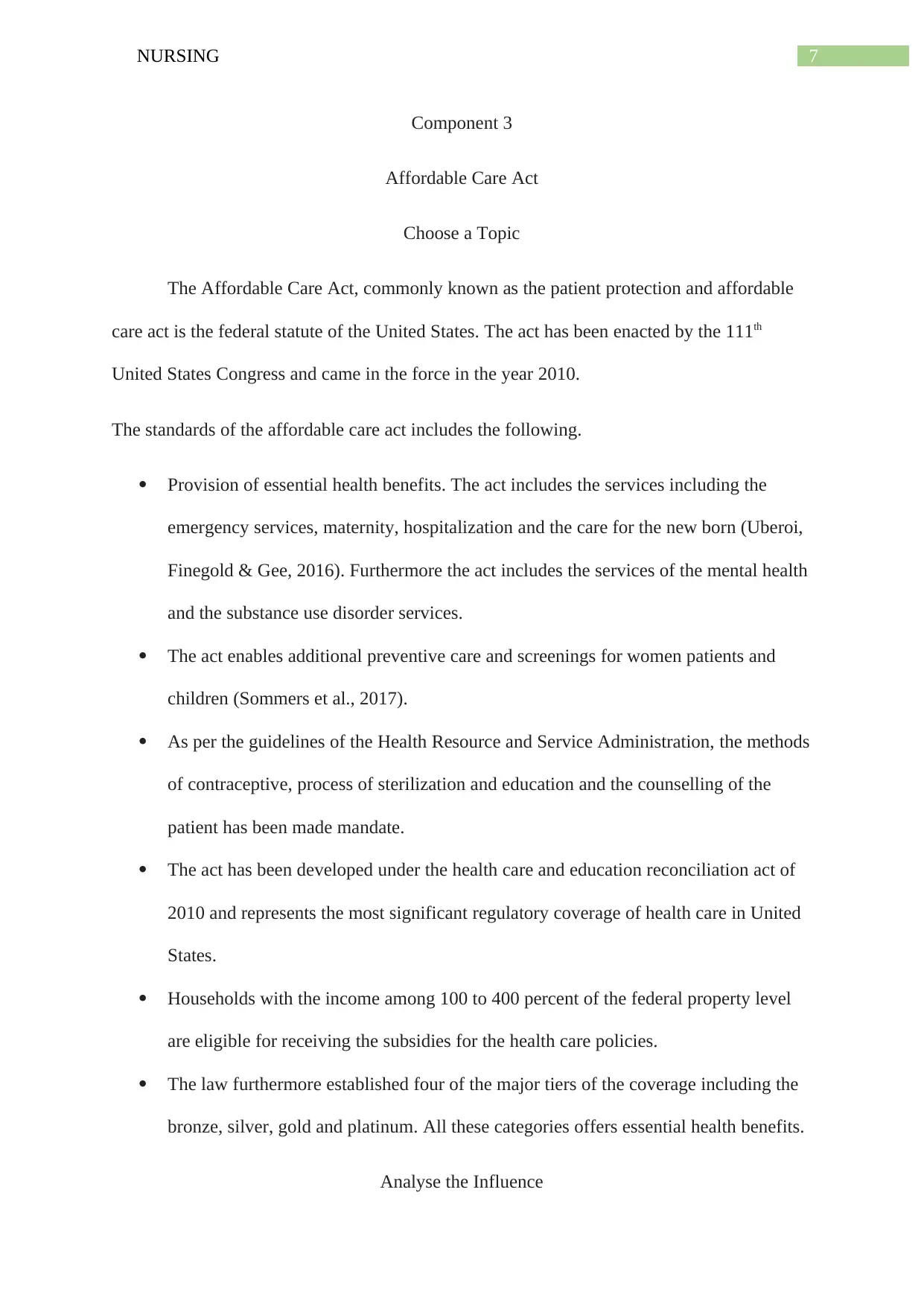
7NURSING
Component 3
Affordable Care Act
Choose a Topic
The Affordable Care Act, commonly known as the patient protection and affordable
care act is the federal statute of the United States. The act has been enacted by the 111th
United States Congress and came in the force in the year 2010.
The standards of the affordable care act includes the following.
Provision of essential health benefits. The act includes the services including the
emergency services, maternity, hospitalization and the care for the new born (Uberoi,
Finegold & Gee, 2016). Furthermore the act includes the services of the mental health
and the substance use disorder services.
The act enables additional preventive care and screenings for women patients and
children (Sommers et al., 2017).
As per the guidelines of the Health Resource and Service Administration, the methods
of contraceptive, process of sterilization and education and the counselling of the
patient has been made mandate.
The act has been developed under the health care and education reconciliation act of
2010 and represents the most significant regulatory coverage of health care in United
States.
Households with the income among 100 to 400 percent of the federal property level
are eligible for receiving the subsidies for the health care policies.
The law furthermore established four of the major tiers of the coverage including the
bronze, silver, gold and platinum. All these categories offers essential health benefits.
Analyse the Influence
Component 3
Affordable Care Act
Choose a Topic
The Affordable Care Act, commonly known as the patient protection and affordable
care act is the federal statute of the United States. The act has been enacted by the 111th
United States Congress and came in the force in the year 2010.
The standards of the affordable care act includes the following.
Provision of essential health benefits. The act includes the services including the
emergency services, maternity, hospitalization and the care for the new born (Uberoi,
Finegold & Gee, 2016). Furthermore the act includes the services of the mental health
and the substance use disorder services.
The act enables additional preventive care and screenings for women patients and
children (Sommers et al., 2017).
As per the guidelines of the Health Resource and Service Administration, the methods
of contraceptive, process of sterilization and education and the counselling of the
patient has been made mandate.
The act has been developed under the health care and education reconciliation act of
2010 and represents the most significant regulatory coverage of health care in United
States.
Households with the income among 100 to 400 percent of the federal property level
are eligible for receiving the subsidies for the health care policies.
The law furthermore established four of the major tiers of the coverage including the
bronze, silver, gold and platinum. All these categories offers essential health benefits.
Analyse the Influence
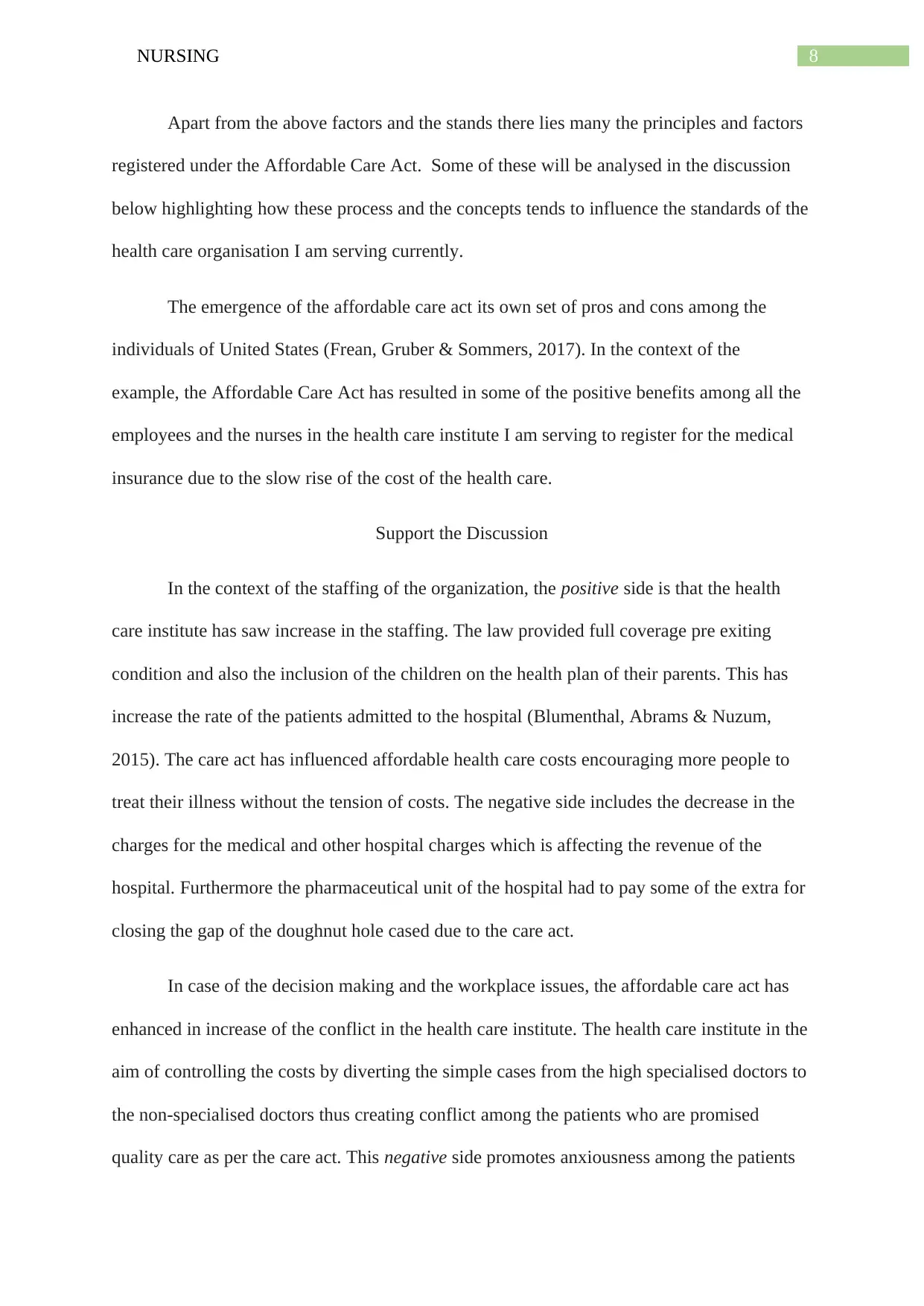
8NURSING
Apart from the above factors and the stands there lies many the principles and factors
registered under the Affordable Care Act. Some of these will be analysed in the discussion
below highlighting how these process and the concepts tends to influence the standards of the
health care organisation I am serving currently.
The emergence of the affordable care act its own set of pros and cons among the
individuals of United States (Frean, Gruber & Sommers, 2017). In the context of the
example, the Affordable Care Act has resulted in some of the positive benefits among all the
employees and the nurses in the health care institute I am serving to register for the medical
insurance due to the slow rise of the cost of the health care.
Support the Discussion
In the context of the staffing of the organization, the positive side is that the health
care institute has saw increase in the staffing. The law provided full coverage pre exiting
condition and also the inclusion of the children on the health plan of their parents. This has
increase the rate of the patients admitted to the hospital (Blumenthal, Abrams & Nuzum,
2015). The care act has influenced affordable health care costs encouraging more people to
treat their illness without the tension of costs. The negative side includes the decrease in the
charges for the medical and other hospital charges which is affecting the revenue of the
hospital. Furthermore the pharmaceutical unit of the hospital had to pay some of the extra for
closing the gap of the doughnut hole cased due to the care act.
In case of the decision making and the workplace issues, the affordable care act has
enhanced in increase of the conflict in the health care institute. The health care institute in the
aim of controlling the costs by diverting the simple cases from the high specialised doctors to
the non-specialised doctors thus creating conflict among the patients who are promised
quality care as per the care act. This negative side promotes anxiousness among the patients
Apart from the above factors and the stands there lies many the principles and factors
registered under the Affordable Care Act. Some of these will be analysed in the discussion
below highlighting how these process and the concepts tends to influence the standards of the
health care organisation I am serving currently.
The emergence of the affordable care act its own set of pros and cons among the
individuals of United States (Frean, Gruber & Sommers, 2017). In the context of the
example, the Affordable Care Act has resulted in some of the positive benefits among all the
employees and the nurses in the health care institute I am serving to register for the medical
insurance due to the slow rise of the cost of the health care.
Support the Discussion
In the context of the staffing of the organization, the positive side is that the health
care institute has saw increase in the staffing. The law provided full coverage pre exiting
condition and also the inclusion of the children on the health plan of their parents. This has
increase the rate of the patients admitted to the hospital (Blumenthal, Abrams & Nuzum,
2015). The care act has influenced affordable health care costs encouraging more people to
treat their illness without the tension of costs. The negative side includes the decrease in the
charges for the medical and other hospital charges which is affecting the revenue of the
hospital. Furthermore the pharmaceutical unit of the hospital had to pay some of the extra for
closing the gap of the doughnut hole cased due to the care act.
In case of the decision making and the workplace issues, the affordable care act has
enhanced in increase of the conflict in the health care institute. The health care institute in the
aim of controlling the costs by diverting the simple cases from the high specialised doctors to
the non-specialised doctors thus creating conflict among the patients who are promised
quality care as per the care act. This negative side promotes anxiousness among the patients
⊘ This is a preview!⊘
Do you want full access?
Subscribe today to unlock all pages.

Trusted by 1+ million students worldwide
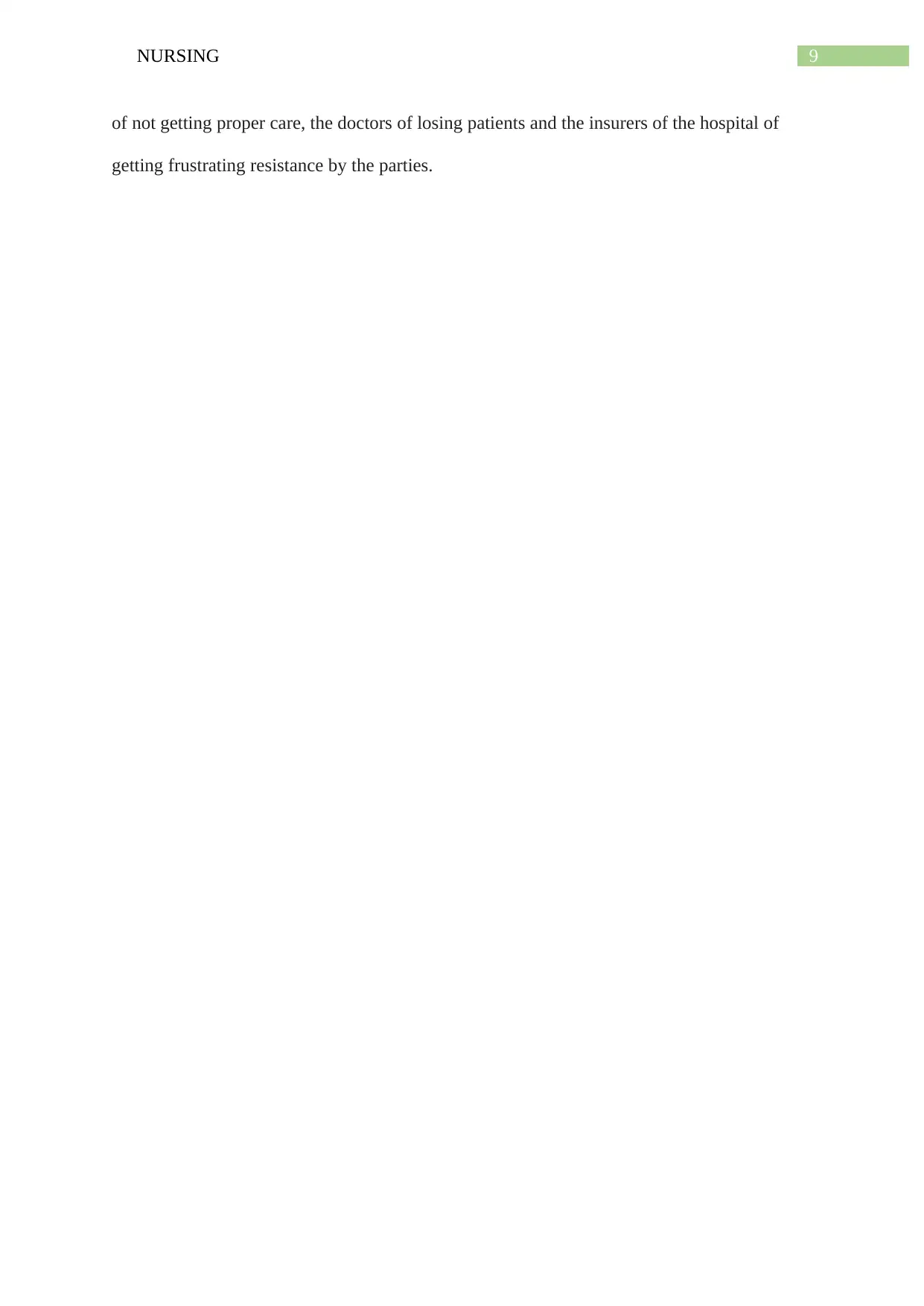
9NURSING
of not getting proper care, the doctors of losing patients and the insurers of the hospital of
getting frustrating resistance by the parties.
of not getting proper care, the doctors of losing patients and the insurers of the hospital of
getting frustrating resistance by the parties.
Paraphrase This Document
Need a fresh take? Get an instant paraphrase of this document with our AI Paraphraser
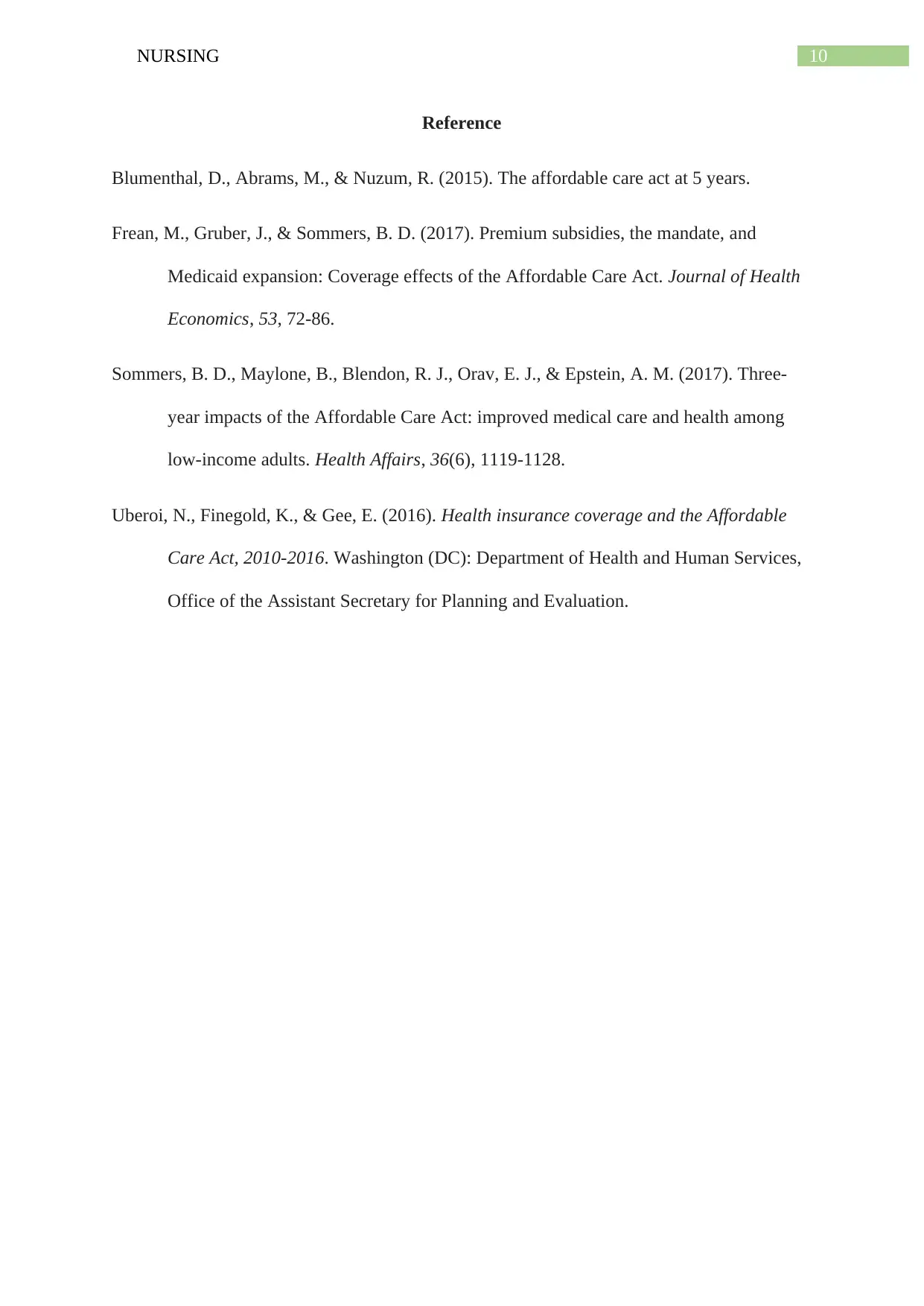
10NURSING
Reference
Blumenthal, D., Abrams, M., & Nuzum, R. (2015). The affordable care act at 5 years.
Frean, M., Gruber, J., & Sommers, B. D. (2017). Premium subsidies, the mandate, and
Medicaid expansion: Coverage effects of the Affordable Care Act. Journal of Health
Economics, 53, 72-86.
Sommers, B. D., Maylone, B., Blendon, R. J., Orav, E. J., & Epstein, A. M. (2017). Three-
year impacts of the Affordable Care Act: improved medical care and health among
low-income adults. Health Affairs, 36(6), 1119-1128.
Uberoi, N., Finegold, K., & Gee, E. (2016). Health insurance coverage and the Affordable
Care Act, 2010-2016. Washington (DC): Department of Health and Human Services,
Office of the Assistant Secretary for Planning and Evaluation.
Reference
Blumenthal, D., Abrams, M., & Nuzum, R. (2015). The affordable care act at 5 years.
Frean, M., Gruber, J., & Sommers, B. D. (2017). Premium subsidies, the mandate, and
Medicaid expansion: Coverage effects of the Affordable Care Act. Journal of Health
Economics, 53, 72-86.
Sommers, B. D., Maylone, B., Blendon, R. J., Orav, E. J., & Epstein, A. M. (2017). Three-
year impacts of the Affordable Care Act: improved medical care and health among
low-income adults. Health Affairs, 36(6), 1119-1128.
Uberoi, N., Finegold, K., & Gee, E. (2016). Health insurance coverage and the Affordable
Care Act, 2010-2016. Washington (DC): Department of Health and Human Services,
Office of the Assistant Secretary for Planning and Evaluation.
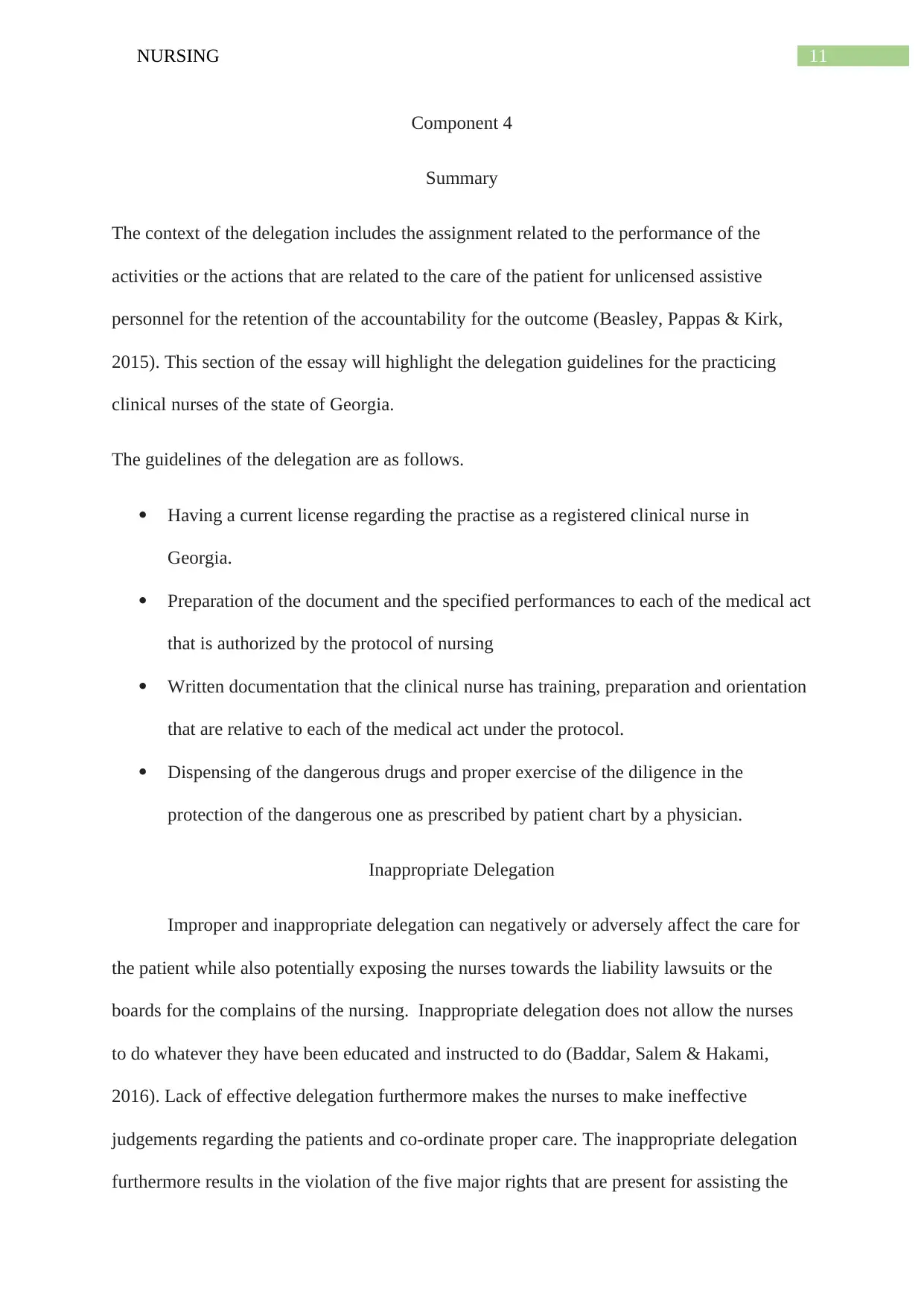
11NURSING
Component 4
Summary
The context of the delegation includes the assignment related to the performance of the
activities or the actions that are related to the care of the patient for unlicensed assistive
personnel for the retention of the accountability for the outcome (Beasley, Pappas & Kirk,
2015). This section of the essay will highlight the delegation guidelines for the practicing
clinical nurses of the state of Georgia.
The guidelines of the delegation are as follows.
Having a current license regarding the practise as a registered clinical nurse in
Georgia.
Preparation of the document and the specified performances to each of the medical act
that is authorized by the protocol of nursing
Written documentation that the clinical nurse has training, preparation and orientation
that are relative to each of the medical act under the protocol.
Dispensing of the dangerous drugs and proper exercise of the diligence in the
protection of the dangerous one as prescribed by patient chart by a physician.
Inappropriate Delegation
Improper and inappropriate delegation can negatively or adversely affect the care for
the patient while also potentially exposing the nurses towards the liability lawsuits or the
boards for the complains of the nursing. Inappropriate delegation does not allow the nurses
to do whatever they have been educated and instructed to do (Baddar, Salem & Hakami,
2016). Lack of effective delegation furthermore makes the nurses to make ineffective
judgements regarding the patients and co-ordinate proper care. The inappropriate delegation
furthermore results in the violation of the five major rights that are present for assisting the
Component 4
Summary
The context of the delegation includes the assignment related to the performance of the
activities or the actions that are related to the care of the patient for unlicensed assistive
personnel for the retention of the accountability for the outcome (Beasley, Pappas & Kirk,
2015). This section of the essay will highlight the delegation guidelines for the practicing
clinical nurses of the state of Georgia.
The guidelines of the delegation are as follows.
Having a current license regarding the practise as a registered clinical nurse in
Georgia.
Preparation of the document and the specified performances to each of the medical act
that is authorized by the protocol of nursing
Written documentation that the clinical nurse has training, preparation and orientation
that are relative to each of the medical act under the protocol.
Dispensing of the dangerous drugs and proper exercise of the diligence in the
protection of the dangerous one as prescribed by patient chart by a physician.
Inappropriate Delegation
Improper and inappropriate delegation can negatively or adversely affect the care for
the patient while also potentially exposing the nurses towards the liability lawsuits or the
boards for the complains of the nursing. Inappropriate delegation does not allow the nurses
to do whatever they have been educated and instructed to do (Baddar, Salem & Hakami,
2016). Lack of effective delegation furthermore makes the nurses to make ineffective
judgements regarding the patients and co-ordinate proper care. The inappropriate delegation
furthermore results in the violation of the five major rights that are present for assisting the
⊘ This is a preview!⊘
Do you want full access?
Subscribe today to unlock all pages.

Trusted by 1+ million students worldwide
1 out of 19
Related Documents
Your All-in-One AI-Powered Toolkit for Academic Success.
+13062052269
info@desklib.com
Available 24*7 on WhatsApp / Email
![[object Object]](/_next/static/media/star-bottom.7253800d.svg)
Unlock your academic potential
Copyright © 2020–2025 A2Z Services. All Rights Reserved. Developed and managed by ZUCOL.





